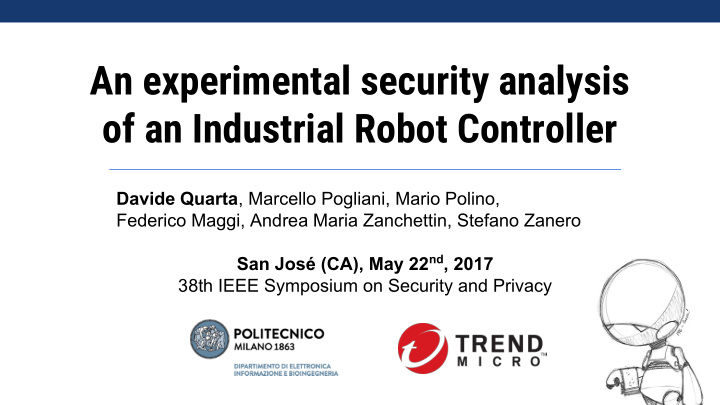



An experimental security analysis of an Industrial Robot Controller Davide Quarta , Marcello Pogliani, Mario Polino, Federico Maggi, Andrea Maria Zanchettin, Stefano Zanero San José (CA), May 22 nd , 2017 38th IEEE Symposium on Security and Privacy
Motivation: Industry 4.0 Trends Interconnected Flexibly programmable Remotely exposed
Motivation: Lack of Awareness Survey : Robot users vs. system security 50 domain experts—users interviewed: 20 answers ➢ 28%* access control policies not enforced ➢ 30% robots accessible over Internet ➢ 76% never performed a pentest ➢ > 50% not a realistic threat * some users did not answer all the questions
How do we define a robot-specific attack?
Requirements: Laws of Robotics ➢ I/O Accuracy ■ Read precise values ■ Issue correct/accurate commands ➢ Safety ■ Never harm humans ■ Correctly inform operator ➢ Integrity ■ No damage to the robot
Requirements: Laws of Robotics ➢ I/O Accuracy ■ Read precise values ■ Issue correct/accurate commands ➢ Safety ■ Never harm humans ■ Correctly inform operator ➢ Integrity ■ No damage to the robot
Requirements: Laws of Robotics ➢ I/O Accuracy ■ Read precise values ■ Issue correct/accurate commands ➢ Safety ■ Never harm humans ■ Correctly inform operator ➢ Integrity ■ No damage to the robot
Requirements: Laws of Robotics ➢ I/O Accuracy ■ Read precise values ■ Issue correct/accurate commands Robot-specific Attack: ➢ Safety Digital-borne violation of any ■ Never harm humans of these requirements ■ Correctly inform operator ➢ Integrity ■ No damage to the robot
5 Robot-specific Attacks
Attack 1: Control Loop Alteration !
Attack 2: Tampering with Calibration Parameters
Attack 3: Tampering with the Production Logic
Attack 4 & 5: (Perceived) Robot State Alteration
Custom Physical Protections, if any (despite regulations)
From Attacks to Threat Scenarios 1) Production Plant Halting 2) Production Outcome Alteration 3) Physical Damage 4) Unauthorized Access 5) Ransom requests to disclose micro defects
Case Study
ARM, Windows CE .NET 3.5 VxWorks 5.x RTOS (PPC, x86) FPGAs and discrete logic
USB port LAN WAN Attack surface Radio
Industrial Routers
Vulnerabilities a. BOF leading to RCE (ABBVU-DMRO-124641) b. BOF in FlexPendant (ABBVU-DMRO-124645) c. BOF in /command endpoint (ABBVU-DMRO-128238) d. Command Injection (ABBVU-DMRO-124642) e. Authentication bypass (ABBVU-DMRO-124644)
Full Controller Exploitation
Attack POCs 1) Accuracy Violation: PID parameters detuning (Attack 1) DEMO 2) Safety Violation: User-Perceived Robot State Alteration (Attack 4) 3) Integrity Violation: Control-loop alteration (Attack 1)
POC 1: accuracy violation (video)
Attack POCs 1) Accuracy Violation: PID parameters detuning (Attack 1) 2) Safety Violation: User-Perceived Robot State Alteration (Attack 4) 3) Integrity Violation: Control-loop alteration (Attack 1)
POC 2: Safety Violation Malicious DLL Teach Pendant
POC 2: Safety Violation Malicious DLL Teach Pendant
Attack POCs 1) Accuracy Violation: PID parameters detuning (Attack 1) 2) Safety Violation: User-Perceived Robot State Alteration (Attack 4) 3) Integrity Violation: Control-loop alteration (Attack 1)
POC 3: Integrity Violation ➢ Robot’s arm collapse on itself ➢ Motors substantially damaged Quite a risky POC! Verified with a robotics’ expert
Conclusions : Future Challenges ➢ New standards, beyond safety issues ➢ Attack detection and hardening ➢ Secure collaborative robots ➢ (Detailed countermeasures in the paper)
http://robosec.org Questions? Davide Quarta , Marcello Pogliani, Mario Polino, Federico Maggi, Andrea Maria Zanchettin, Stefano Zanero San José (CA), May 22 nd , 2017 38th IEEE Symposium on Security and Privacy
Recommend
More recommend